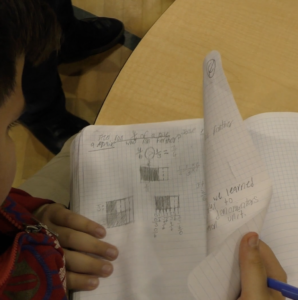This course for K-6 educators explores the power of student reflective journals in building students’ mathematical knowledge and practices.

Welcome
Welcome to the online course Try Journals in Your Classroom. This course is designed for educators who would like to use reflective mathematics journals with their students. Most examples come from K-6 classrooms, but we hope secondary educators will also try these strategies and share their learning with us!
What Will I Learn?
This course is designed to help you:
- Understand how journal use can build students’ mathematical knowledge and practices
- Launch journals in your classroom
- Review students’ journals for evidence to help you strengthen your mathematics teaching and plan next instructional steps
- Use journals to deepen students’
- Use of prior knowledge
- Use of mathematical tools (like expressions and diagrams)
- Reflection on their own mathematical learning
- Mathematical conversations and reasoning
- Use of the evidence to construct viable arguments
- Mathematical mindsets (like agency, perseverance, and interest)
What is the Course Structure?
The course includes four ordered modules, as shown below. The fourth module has multiple inquiries that are flexible in order.
| Course Structure | Estimated Time Needed to Complete |
| Module 1: Why Reflective Journals? | 1 hour |
| Module 2: Getting Started - Launching Journals | 1 hour |
| Module 3: Reflecting on your Journal implementation | ongoing |
| Module 4: Dive Deeper into Journals Through Inquiry | 5-30 hours depending on number of inquiries done |
| Inquiry A: How are Students Using Prior Knowledge to Make Sense of New or Puzzling Ideas? | 5 hours |
| Inquiry B: How are Students Using Mathematical Expressions, Diagrams, and Other Important Tools of Mathematics? | 5 hours |
| Inquiry C: How are Students Reflecting on their Own Mathematical Learning? | 5 hours |
| Inquiry D: How Do Conversations Support Journal Writing in Your Classroom? How Does Journal Writing Support Classroom Conversations? | 5 hours |
| Inquiry E: How Does Board Writing Support Journal Writing in Your Classroom? How Does Journal Writing Support Board Writing? | 5 hours |
| Inquiry F: Are Students Developing Mathematical Agency, Perseverance, and Interest? | 5 hours |
Is the Course for Individuals or Teams?
This course can be completed individually or as a team. Throughout the course, you will need a classroom where you can try out what you learn and study the resulting student journals. We strongly recommend, whether you are working individually or as a team, that you keep notes that capture your insights, questions, and reflections as you take the course. Maybe you will want to use in your own notes some of the nifty strategies you will be encouraging students to use–such as using thought bubbles to reflect “aha’s” or circling and explaining changes in thinking, rather than erasing.
For those working as a team: Working as a team, or as a whole school, can be very powerful, since you can help students build habits of reflection that will benefit them for many years. (Contact us if you want to connect with schools using reflective mathematics journals school-wide.) Before you begin, we encourage you to agree on norms and logistics for working together (see links to our Conduct a Cycle resources below). As you proceed through the course, we encourage you to adopt a “Reflect, then Discuss” approach–to take a few moment to reflect individually on your own ideas, observations and experiences before sharing and discussing with the group. In general, providing time for individual reflection before group discussion supports deeper discussions.

